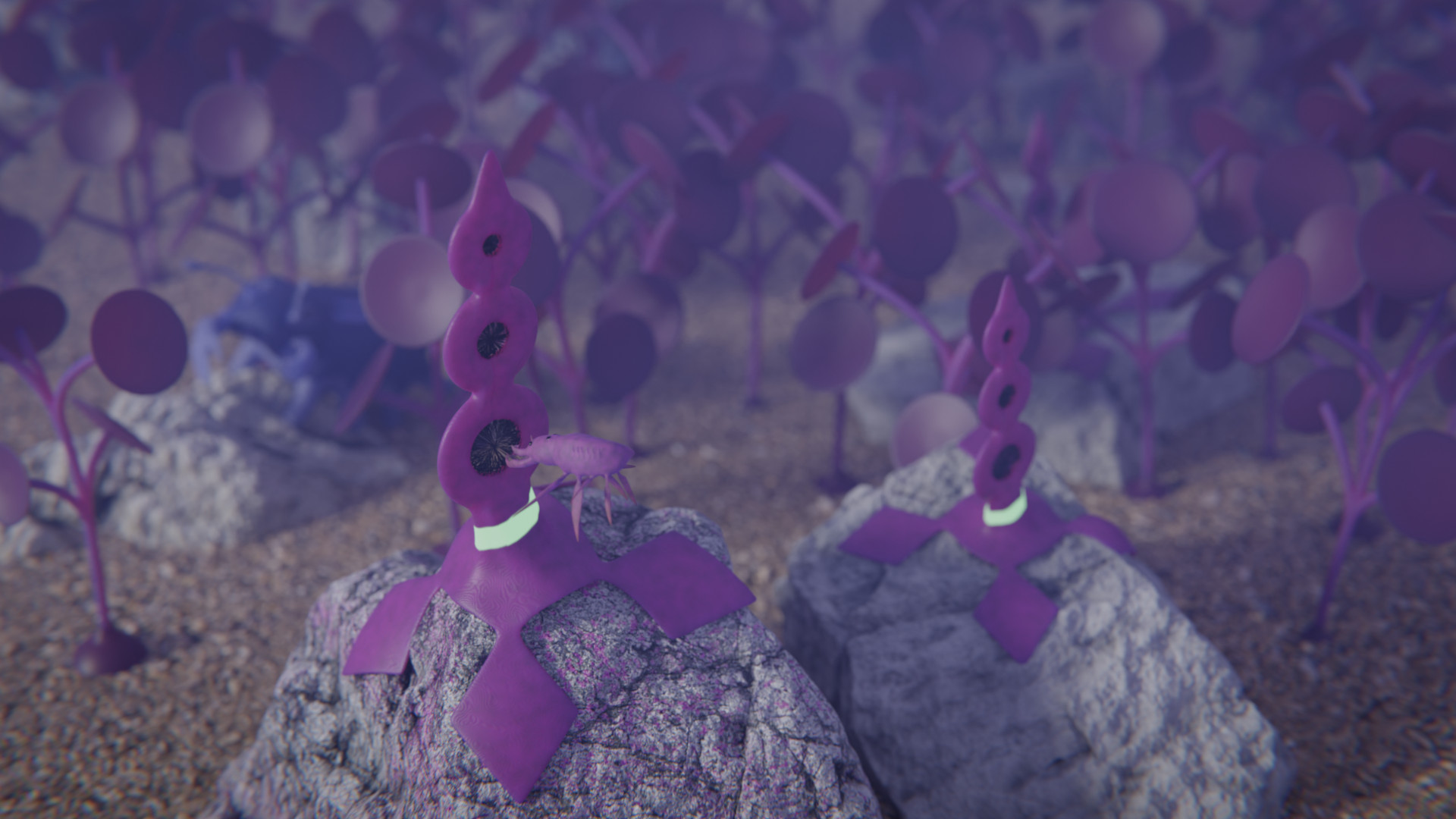Boreno
Boreno is a retinalphyte with a nearly world wide distribution. It lives comnsually with a number of organisms serving as a cleaning station removing organic debris from creatures small enough to fit through its rings, which it then breaks down for additional minerals and vitamins that it finds scarce growing on the rocks it calls home. Pictured here a Protamisa mopsalidi is about to scrape itself past the bristles of a boreno ring. [Creature design by August Ristow]
Basic Information
Anatomy
Boreno consists of a circular base with 4 trapezoidal sections facing outward and 3-10 rings vertically growing out of a cylinder attached to the top of the base. The bottom of each section is covered in water sensitive cells and secrets a sticky substance to keep it stuck to seabed. A cylinder protrudes from the center of the base. A bioluminescent stripe of chemical producing cells loops around the middle of the cylinder. The top of the cylinder forms a hoop from which 3-7 other rings will vertically grow, forming a tower. The hoops are used for photosynthesis and nutrients collection. The hoops also produce small internal air bubbles keeping the plant upright. The very top hoop will form a small cone structure called an oovlet, which is used for reproduction. Oovlets will only grow once the final hoop is developed. Boreno can fuse sections, but only with its direct relatives. Boreno can tell what is a relative and what is not by using a chemical tag. These are produced in the bioluminescent stripe. When two Boreno touch sections, they exchange chemical tags, if half of tag matches the others the two will fuse. The chemical tags move through specialized veins located throughout the lower half of the Boreno. Each trapezoidal section is roughly 3-5 inches from end to end. oovlets are usually 1-19 cm. The first ring is usually 1-1.3 inches. The base is usually 4-6 inches across. The hoops grow stiff bristles which while capable of gathering plankton in small amounts are mostly used by creatures that can fit through the ring to scrape off ectoparasites, which the boreno will then digest externally to gain additional nutrients and minerals. The bioluminescent strips serve not only as the source for chemical tags that allow boreno individuals to merge, but also as a sign post for various organisms to find the boreno so that they can clean themselves.
Genetics and Reproduction
Borneo reproduces asexually using its oovlet, which produces 6-20 buds that are released into the current every reproductive cycle. These cycles depend on available nutrients and sunlight.
Growth Rate & Stages
Boreno development is split into 6 stages
Stage 1: Once a bud lands on a sturdy surface it will flatten itself along the surface. Its body will become a thin disk with a small protrusion coming from the center. It uses small clamps to hold to the surface. At this stage it is 3-6.3 cm across and 3-4 mm tall.
Stage 2: the disk will slowly enlarge and the development of its trapezoidal segments will begin as well as the growth of its cylinder. The base is 1-1.4 inches across and 6mm tall.
Stage 3: The disk has completed it growth and is 4 inches long and 6mm tall. The cylinder has almost completed its development and is 1-2 inches tall. The trapezoidal sections have also completed development and begin to produce adhesive.
Stage 4: Boreno loses its clamps and relies entirely on the adhesive to keep it on the ground. The first ring is developing out of the top of the cylinder and the development of the bioluminescent stripe has begun.
Stage 5: the first ring and bioluminescent stripe have finished development and now fully functional. Boreno has begun to grow more rings from the top of the first one.
Stage 6: the final ring is grown and the Oovlet has been produced and is functioning. The entirety of the Boreno is 1-2 ft tall.
Ecology and Habitats
Boreno is found attached to rocks in shallow salty waters all around Almaishah Ecept around Yama, southern Natash, southern Borea, eastern Ras al-kalb, and far northern Arctica.











Comments